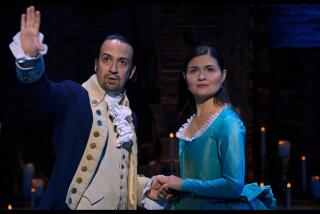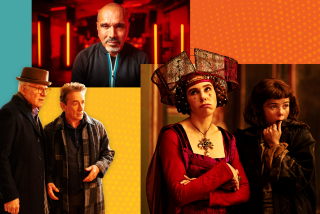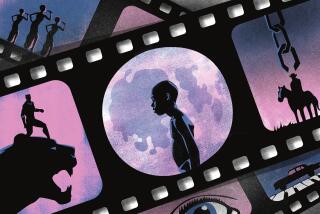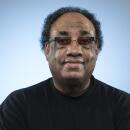Tuning In to ‘Amos ‘n’ Andy’ Again
Finally, America’s all-time funniest television series is available on video, trumpets the TV ad. Like memories of an era long past but not forgotten, scenes of the stars insulting and joshing each other unfold once again.
But unlike “Leave It to Beaver” or “Green Acres,” the return of “The Amos ‘n’ Andy Show” is not merely a case of another beloved series riding the nostalgia wave.
Driven by a stream of publicity and public awareness, the show is emerging from the shadows of a stormy past into a new light of rediscovery. And much of the increased interest comes from African Americans who are viewing the series with a new perspective.
For 31 years, “Amos ‘n’ Andy” has been virtually banished from television. The situation comedy about a Harlem-based group of lodge brothers--the first network show to feature an all-black cast--ran on CBS from 1951 to 1953. It then continued in reruns but was unceremoniously withdrawn from syndication in 1966 by CBS, which considered it too controversial because of prolonged protests by the NAACP over the way the characters spoke and behaved.
The furor over the series and legal disputes about who owns the rights to the program have combined to keep “Amos ‘n’ Andy” largely underground.
Most Americans have not been able to see the show since it went off the air, giving it almost a mythical status with a generation of TV fans. For years, episodes were only sold quietly through collectors and smaller nostalgia video outfits.
But now, a home video distributor has launched an aggressive marketing campaign as it makes episodes more widely available in such major outlets as Tower Records. Director Robert Altman and entertainer Harry Belafonte have announced plans for a movie about “Amos ‘n’ Andy.”
The show still troubles many people. But mixed feelings about contemporary African American sitcoms and movies containing what some observers call outrageous characters and situations have prompted more interest in seeking out “Amos ‘n’ Andy” for comparison. And with the growing prominence of black writers, producers and directors, as well as a greater variety of roles for blacks, some African Americans and others regard “Amos ‘n’ Andy” with less resistance than they did in the past, when the involvement of blacks in Hollywood was more stereotyped and restricted.
“Most things mellow out over time, and what may have been offensive at one point is now comical,” said Todd Boyd, an African American who is assistant professor of critical studies at USC’s School of Cinema-Television. “As time passes, different circumstances arise and context changes. With quite a bit of historical distance, there is a different approach that we can apply in the 1990s that we could not apply before.”
“I have ‘Amos ‘n’ Andy’ in my own collection. I go back and look at them and genuinely laugh,” said African American actress-director Anna Maria Horsford, who co-stars in the WB network’s “The Wayans Bros.” “It’s just like ‘I Married Joan’ or any other comedy during that time. It was just a slice of life of who these people are.”
Even the national NAACP, which was instrumental in getting “Amos ‘n’ Andy” off the air, has taken a hands-off position on the series this time around, declining to comment on the show’s resurgence. The president of the organization’s Beverly Hills/Hollywood chapter says “Amos ‘n’ Andy” in many respects is more dignified than many black-oriented sitcoms on the air today.
Not everyone is laughing. The show can still provoke emotional responses from many African Americans.
“There is a stunning lack of consensus among black viewers when it comes to ‘Amos ‘n’ Andy,’ ” said Melvin Patrick Ely, a professor of history and black studies at the College of William & Mary in Virginia, and author of “The Adventures of Amos ‘n’ Andy: A Social History of an American Phenomenon.”
“Sometimes I will give talks on the series, and then show about five minutes of clips,” Ely said. “At times audiences are very receptive and friendly, while others find it a total turn-off. Seeing it turns their stomach. I don’t think there will ever be agreement on ‘Amos ‘n’ Andy.’ ”
And some observers have objected to the packaging of the videos by Arizona-based Bridgestone Multimedia Co., which is making the current home video push. It makes no reference to the historical context of the images or the controversy surrounding the show.
“History taken out of context is inappropriate, and ‘Amos ‘n’ Andy’ has a history that is so rooted in controversy that it needs to be examined at the same time,” said USC’s Boyd. “To bring it back without examining the content is as problematic as acting as if [the controversy] never existed.”
To counter such concerns, Bridgestone is making available an “Amos ‘n’ Andy” documentary made in the 1970s and narrated by the late comedian George Kirby. Shelly Barrios-LeVeille, vice president of sales and marketing, said the company hopes this will help put the series in perspective.
Bridgestone--collaborating with a collector who has master tapes of most of the series’ 78 episodes--began releasing the shows about six months ago in a two-video set containing 10 episodes. Executives said they felt they would fit perfectly into their budget-priced line of old television series.
As of June, the company had shipped more than 40,000 units, which makes “Amos ‘n’ Andy” one of its biggest sellers. Several other small video distributors have sold “Amos ‘n’ Andy” over the years, but only Bridgestone has used a high-profile marketing campaign.
“There was some question about it initially, about [the show] being politically incorrect, but when we looked at it, we didn’t see it that way,” said Barrios-LeVeille.
“True, the people on the show are not the best role models, but the actors gave them dignity. They did the best they could under the circumstances.”
While many blacks still refer to “Amos ‘n’ Andy” as the pioneer in stereotypical portrayals of blacks on TV, the show has also had its defenders--blacks as well as whites--who maintain that the sharply written comedy, the likability of the characters and the chemistry of the actors transcend racial overtones.
Jim Maxwell, 43, of Thousand Oaks, said he remembers enjoying the comedy when he was a 10-year-old watching TV after school. He said he has amassed a collection of about 60 episodes.
“It’s just plain funny, and I never thought about race at all when I watched it,” said Maxwell, an optical technician who is white.
And performers and scholars increasingly are seeing “Amos ‘n’ Andy” as a historical and cultural cornerstone.
“We need to look and point with pride to ‘Amos ‘n’ Andy,’ and what those actors accomplished,” said James Avery, an African American who co-starred in “The Fresh Prince of Bel-Air” and now appears in the UPN comedy “Sparks.” “They made the best of a bad situation by acting with dignity. They made it possible for ‘The Autobiography of Miss Jane Pittman,’ for ‘Sounder,’ for Alfre Woodard. Every black actor working owes a debt to them, [and] to Hattie McDaniel, to Stepin Fetchit. They set this all up.”
*
*
Two white entertainers, Freeman Gosden and Charles Correll, created the “Amos ‘n’ Andy” show and played all of the male parts when the series premiered on NBC radio in 1929. Despite some NAACP leaders’ complaints about negative images, the show was successful with both black and white listeners. It became such a hit that broadcasts were piped into restaurants and movie theaters so patrons could be assured of not missing an episode.
The featured characters were Amos Jones, a philosophical cabdriver; Andy Brown, his gullible, rotund and unassuming friend, and George Stevens, the head of the Mystic Knights of the Sea Lodge, which earned him the more familiar nickname of “the Kingfish.” Also included in the ensemble was a lazy-talking janitor, Lightin’, and a fast-talking attorney, Algonquin J. Calhoun.
“The Kingfish” was often at the center of the action as he schemed to make a fast buck or swindle Andy out of a few dollars. “The Kingfish” regularly butted heads with his wife, Sapphire, and his sour-faced mother-in-law, and became well known for his exclamation, “Holy mackerel!”
Gosden and Correll later sold the rights to their characters to CBS, which wanted to produce a TV version. Obviously, the pair could not re-create their multiple black characters on television, prompting a search for black actors to take over the parts. When “The Amos ‘n’ Andy Show” premiered on CBS in June 1951, it had three new stars: Alvin Childress as Amos, Spencer Williams Jr. as Andy, and Tim Moore as Kingfish.
While some fans were delighted to see the characters they had grown to love on radio, what had worked audibly had a different effect on TV. Black audiences were divided when confronted with the visual reality of the show. Some of the characters were contentedly unemployed; some were blatantly deceitful. The men spoke in a heavy black dialect with little regard for the English language. Dialogue consisted of lines such as, “We’s all got to stick together in dis heah thing.”
“Amos ‘n’ Andy” was immediately attacked by the NAACP. The series, members said in a resolution passed at a 1951 convention, showed “the Negro and other minority groups in a stereotyped and derogatory manner” and tended to “strengthen the conclusion among uninformed or prejudiced people that Negroes and other minorities are inferior, dumb, lazy and dishonest.”
The disenchantment reflected the unhappiness surrounding the stereotypical roles played by black film stars of the period, who were often hired to play servants.
In fact, civil rights activist Julian Bond said recently, “There were no other portrayals of blacks on TV other than ‘Amos ‘n’ Andy.’ It was seen as being bad because it stood alone. It made fun of black women, showed them as being fat, loudmouthed and ugly in every way.”
But a large black audience still tuned in. In addition to the comic antics of the core characters, they saw peripheral characters who were black doctors or lawyers.
“There were hundreds of thousands of viewers--both white and black--who had no idea there were black professionals who had gone to college until ‘Amos ‘n’ Andy,’ ” said Ely. “The show made a very clear contribution in showing that.”
Today, much of the renewed interest comes from African Americans. Young adults who have never seen the series, and their parents, who saw and loved it the first time around, have been seeking out episodes.
“I’ve got people from their 20s to their 40s constantly calling me for tapes,” said Mayme A. Clayton, curator of the Western States Black Research and Educational Center, which specializes in black film memorabilia. “They don’t view these shows in the same light that older people did. They see it just as a good comedy.”
Donavan Brandt is one of the owners of the family-run Eddie Brandt Video/Saturday Matinee outlet in North Hollywood, which specializes in older shows and films. The shows “have been very popular, and 70% to 80% of the people who ask for them are black,” he said. “We had a big rush on them for Father’s Day, all these 25- to 40-year-olds who wanted to give them as gifts.”
*
*
It is unlikely that “Amos ‘n’ Andy” will make a full-scale comeback or be rerun on television any time soon.
For one thing, there is continuing debate over who owns the old episodes. Bridgestone and other video distributors maintain that they are in the public domain, while CBS insists that it retains ownership. “We are currently investigating the facts in this case,” a CBS spokesman said. “But as a matter of policy, we aggressively pursue any and all parties that violate our copyright protection.”
For another, there is still wariness over how a national broadcast would be received. “Amos ‘n’ Andy” is not being considered for revival on Nick at Nite or TV Land, cable channels that specialize in rerunning old shows. A spokesman for Black Entertainment Television, which airs some reruns of black shows formerly seen on major networks, said the cable outlet also had no plans to air the series, adding that it would only do so if the episodes were accompanied by supplemental programming that would give the show historical context.
Yet it is in part because of what is on television today that “Amos ‘n’ Andy” is being viewed with a fresh perspective. While black-oriented situation comedies such as “The Wayans Bros.,” “Martin,” “The Jamie Foxx Show” and “Malcolm & Eddie” have solid followings, particularly with younger urban viewers, some critics and older viewers have complained of their buffoonish images of African Americans.
“The shows that are on now are much more extreme than ‘Amos ‘n’ Andy’ ever was,” said Freeman Gosden Jr., the son of the series’ co-creator.
Billie J. Greene, president of the Beverly Hills/Hollywood chapter of the NAACP, launched a protest this year against eight black network comedies, saying they were “horrible” representations of black America.
“When you look at ‘Amos ‘n’ Andy’ now, it really doesn’t seem that bad when put beside these other shows,” she said. “The dialect was one of the big problems, so if you can get past that, it’s more acceptable.”
More to Read
The complete guide to home viewing
Get Screen Gab for everything about the TV shows and streaming movies everyone’s talking about.
You may occasionally receive promotional content from the Los Angeles Times.







